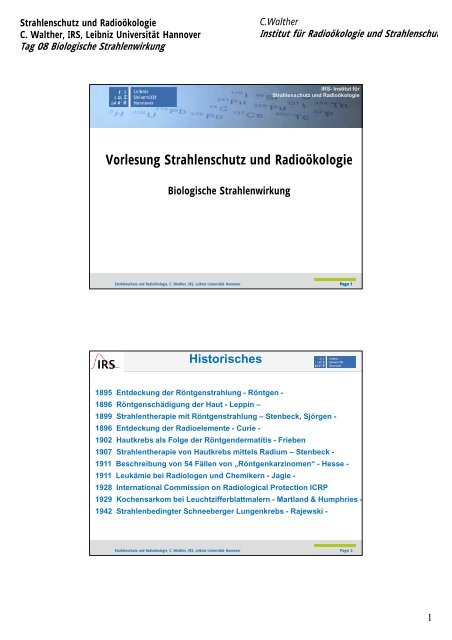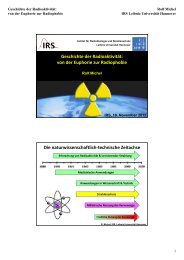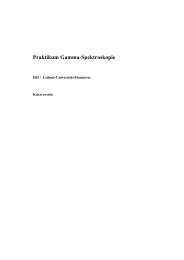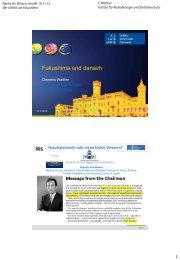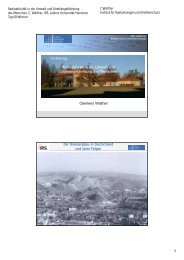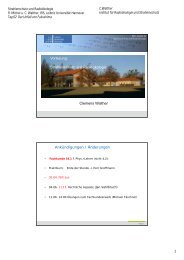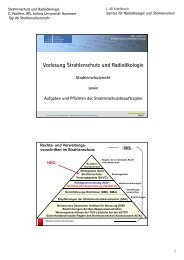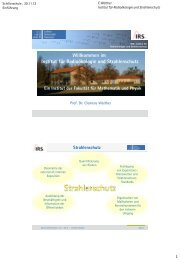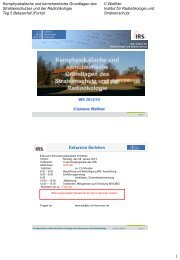Vorlesung Strahlenschutz und Radioökologie - IRS - Leibniz ...
Vorlesung Strahlenschutz und Radioökologie - IRS - Leibniz ...
Vorlesung Strahlenschutz und Radioökologie - IRS - Leibniz ...
Erfolgreiche ePaper selbst erstellen
Machen Sie aus Ihren PDF Publikationen ein blätterbares Flipbook mit unserer einzigartigen Google optimierten e-Paper Software.
<strong>Strahlenschutz</strong> <strong>und</strong> <strong>Radioökologie</strong><br />
C. Walther, <strong>IRS</strong>, <strong>Leibniz</strong> Universität Hannover<br />
Tag 08 Biologische Strahlenwirkung<br />
C.Walther<br />
Institut für <strong>Radioökologie</strong> <strong>und</strong> Strahlenschut<br />
<strong>IRS</strong>- Institut für<br />
<strong>Strahlenschutz</strong> <strong>und</strong> <strong>Radioökologie</strong><br />
<strong>Vorlesung</strong> <strong>Strahlenschutz</strong> <strong>und</strong> <strong>Radioökologie</strong><br />
Biologische Strahlenwirkung<br />
<strong>Strahlenschutz</strong> <strong>und</strong> <strong>Radioökologie</strong>, C. Walther, <strong>IRS</strong>, <strong>Leibniz</strong> Universität Hannover Page 1<br />
Historisches<br />
1895 Entdeckung der Röntgenstrahlung - Röntgen -<br />
1896 Röntgenschädigung der Haut - Leppin –<br />
1899 Strahlentherapie mit Röntgenstrahlung – Stenbeck, Sjörgen -<br />
1896 Entdeckung der Radioelemente - Curie -<br />
1902 Hautkrebs als Folge der Röntgendermatitis - Frieben<br />
1907 Strahlentherapie von Hautkrebs mittels Radium – Stenbeck -<br />
1911 Beschreibung von 54 Fällen von „Röntgenkarzinomen“ - Hesse -<br />
1911 Leukämie bei Radiologen <strong>und</strong> Chemikern - Jagie -<br />
1928 International Commission on Radiological Protection ICRP<br />
1929 Kochensarkom bei Leuchtzifferblattmalern - Martland & Humphries -<br />
1942 Strahlenbedingter Schneeberger Lungenkrebs - Rajewski -<br />
<strong>Strahlenschutz</strong> <strong>und</strong> <strong>Radioökologie</strong>, C. Walther, <strong>IRS</strong>, <strong>Leibniz</strong> Universität Hannover Page 2<br />
1
<strong>Strahlenschutz</strong> <strong>und</strong> <strong>Radioökologie</strong><br />
C. Walther, <strong>IRS</strong>, <strong>Leibniz</strong> Universität Hannover<br />
Tag 08 Biologische Strahlenwirkung<br />
C.Walther<br />
Institut für <strong>Radioökologie</strong> <strong>und</strong> Strahlenschut<br />
Die Hand des Anatomen Geheimrat<br />
von Kolliker in Würzburg,<br />
aufgenommen<br />
am 23.01.1896 von W.C. Röntgen<br />
(1845 – 1923)<br />
W.C. Röntgen erhält 1901 den<br />
Nobelpreis für Physik.<br />
<strong>Strahlenschutz</strong> <strong>und</strong> <strong>Radioökologie</strong>, C. Walther, <strong>IRS</strong>, <strong>Leibniz</strong> Universität Hannover Page 3<br />
Röntgenuntersuchung 1906<br />
<strong>Strahlenschutz</strong> <strong>und</strong> <strong>Radioökologie</strong>, C. Walther, <strong>IRS</strong>, <strong>Leibniz</strong> Universität Hannover Page 4<br />
2
<strong>Strahlenschutz</strong> <strong>und</strong> <strong>Radioökologie</strong><br />
C. Walther, <strong>IRS</strong>, <strong>Leibniz</strong> Universität Hannover<br />
Tag 08 Biologische Strahlenwirkung<br />
Erste Krebstherapie mit Röntgenstrahlung<br />
im Jahr 1899<br />
C.Walther<br />
Institut für <strong>Radioökologie</strong> <strong>und</strong> Strahlenschut<br />
<strong>Strahlenschutz</strong> <strong>und</strong> <strong>Radioökologie</strong>, C. Walther, <strong>IRS</strong>, <strong>Leibniz</strong> Universität Hannover Page 5<br />
Röntgenkarzinom<br />
Thor Stenbeck behandelte ein<br />
Basalzellenkarzionom der Nase<br />
einer 49-Jahre-alten Frau. 100<br />
Behandlungen im Verlaufe von 9<br />
Monaten. Die Patienten überlebte<br />
bei guter Ges<strong>und</strong>heit 30 Jahre.<br />
Tage Sjörgen heilte ein Epithelzellenkarzinom<br />
mit 50 Behandlungen<br />
im Verlauf von 30 Monaten.<br />
1896 Röntgenschädigung der Haut<br />
1902 Hautkrebs als Folge der Röntgendermatitis<br />
<strong>Strahlenschutz</strong> <strong>und</strong> <strong>Radioökologie</strong>, C. Walther, <strong>IRS</strong>, <strong>Leibniz</strong> Universität Hannover Page 6<br />
3
<strong>Strahlenschutz</strong> <strong>und</strong> <strong>Radioökologie</strong><br />
C. Walther, <strong>IRS</strong>, <strong>Leibniz</strong> Universität Hannover<br />
Tag 08 Biologische Strahlenwirkung<br />
X-Ray Examination<br />
C.Walther<br />
Institut für <strong>Radioökologie</strong> <strong>und</strong> Strahlenschut<br />
<strong>Strahlenschutz</strong> <strong>und</strong> <strong>Radioökologie</strong>, C. Walther, <strong>IRS</strong>, <strong>Leibniz</strong> Universität Hannover Page 7<br />
Entdeckung der Radioaktivität<br />
1896 durch Henry Becquerel<br />
Radiation injury to<br />
the skin of a<br />
Spanish-American-<br />
War soldier as a<br />
result of X-ray<br />
examination<br />
(1898)<br />
Wambersie,<br />
Heraeus Physics<br />
School (2009)<br />
<strong>Strahlenschutz</strong> <strong>und</strong> <strong>Radioökologie</strong>, C. Walther, <strong>IRS</strong>, <strong>Leibniz</strong> Universität Hannover Page 8<br />
4
<strong>Strahlenschutz</strong> <strong>und</strong> <strong>Radioökologie</strong><br />
C. Walther, <strong>IRS</strong>, <strong>Leibniz</strong> Universität Hannover<br />
Tag 08 Biologische Strahlenwirkung<br />
Historie<br />
C.Walther<br />
Institut für <strong>Radioökologie</strong> <strong>und</strong> Strahlenschut<br />
08.11.1895 Entdeckung der Röntgenstrahlung (X-rays)<br />
20.01.1896 Henri Poincaré interpretiert die unbekannte Strahlung als<br />
Fluoreszenz der Röhrenwand <strong>und</strong> vermutet, dass andere<br />
fluoreszierende Substanzen sowohl sichtbares Licht als auch<br />
Röntgenstrahlung emittieren könnten.<br />
24.02.1896 Henri Becquerel berichtet der A.F., dass dem Sonnenlicht<br />
ausgesetztes Uranylsulfat, die einzige wirklich phosphorisierende<br />
Substanz, eine lichtdicht verpackte Photoplatte durch eine<br />
Aluminiumfolie hindurch schwärzt.<br />
29.02.1896 Henri Becquerel beobachtet, dass der Effekt auch ohne<br />
Bestrahlung des Uranylsulfat durch Licht auftritt <strong>und</strong> dass die<br />
Absorption der Strahlungsaktivität mit der Dicke eines<br />
Kupferabsorbers zunimmt. Er beobachtet auch, dass die<br />
Uranstrahlen die Leitfähigkeit der Luft beeinflussen. Der Effekt ist<br />
am stärksten in Uranmetall <strong>und</strong> unabhängig vom physikalischen<br />
Zustand.<br />
Die Natur der Strahlung blieb unbekannt <strong>und</strong> niemand interessierte sich dafür.<br />
<strong>Strahlenschutz</strong> <strong>und</strong> <strong>Radioökologie</strong>, C. Walther, <strong>IRS</strong>, <strong>Leibniz</strong> Universität Hannover Page 9<br />
Marie Curie (née Marya Sklodowska)<br />
Marya Sklodowska (1867 – 1934) heiratete 1895 in Paris den Physiker<br />
Pierre Curie (1859 – 1906), der bereits für seine Arbeiten über den<br />
Magnetismus (Curie Temperatur) <strong>und</strong> die Kristallsymetrie bekannt war.<br />
Er hatte mit seinem Bruder Jacques 1882 den piezoelektrischen Effekt<br />
entdeckt.<br />
Marie Curie wählt als Gegenstand ihrer Doktorarbeit die von Henri<br />
Becquerel beschriebenen Phänomene, insbesondere das von<br />
Becquerel beschriebene Problem, dass die Fähigkeit von<br />
Uranverbindungen, Fotoplatten zu schwärzen, mit der Zeit nicht<br />
abnimmt.<br />
Woher kam die kontinuierliche Emission von Energie?<br />
<strong>Strahlenschutz</strong> <strong>und</strong> <strong>Radioökologie</strong>, C. Walther, <strong>IRS</strong>, <strong>Leibniz</strong> Universität Hannover Page 10<br />
5
<strong>Strahlenschutz</strong> <strong>und</strong> <strong>Radioökologie</strong><br />
C. Walther, <strong>IRS</strong>, <strong>Leibniz</strong> Universität Hannover<br />
Tag 08 Biologische Strahlenwirkung<br />
Marie Curie wählt als Nachweismethode für<br />
die unbekannte Strahlung die<br />
Wechselwirkung mit Luft.<br />
C.Walther<br />
Institut für <strong>Radioökologie</strong> <strong>und</strong> Strahlenschut<br />
Erste Quantifizierung der<br />
Uranstrahlen durch eine<br />
Stromstärke (~pA) oder<br />
eine elektrische Ladung.<br />
Quellstärke in Gramm.<br />
<strong>Strahlenschutz</strong> <strong>und</strong> <strong>Radioökologie</strong>, C. Walther, <strong>IRS</strong>, <strong>Leibniz</strong> Universität Hannover Page 11<br />
Thorium strahlt!<br />
1898 Gerhard S. Schmidt (Erlangen) <strong>und</strong> Marie Curie entdecken<br />
unabhängig voneinander die Radioaktivität des Thorium.<br />
Marie Curie:<br />
� Die Intensität der Strahlung von Uran- <strong>und</strong> Thorium-verbindungen<br />
ist ungefähr proportional zum Gehalt des jeweiligen Elementes.<br />
(Premiere der Radioanalytik)<br />
� Die Strahlung ist unabhängig von physikalischen <strong>und</strong> chemischen<br />
Zustand des Elementes.<br />
� Pechblende sendet viermal mehr Strahlung aus als metallisches<br />
Uran.<br />
Hypothese: Die Mineralien enthalten ein Element,<br />
das viel stärker strahlt als Uran.<br />
<strong>Strahlenschutz</strong> <strong>und</strong> <strong>Radioökologie</strong>, C. Walther, <strong>IRS</strong>, <strong>Leibniz</strong> Universität Hannover Page 12<br />
6
<strong>Strahlenschutz</strong> <strong>und</strong> <strong>Radioökologie</strong><br />
C. Walther, <strong>IRS</strong>, <strong>Leibniz</strong> Universität Hannover<br />
Tag 08 Biologische Strahlenwirkung<br />
Entdeckung der radioaktiven<br />
Elemente Thorium, Polonium,<br />
Radium <strong>und</strong> einer neuen<br />
Chemie: der Radiochemie<br />
Die Curies<br />
im Labor<br />
C.Walther<br />
Institut für <strong>Radioökologie</strong> <strong>und</strong> Strahlenschut<br />
<strong>Strahlenschutz</strong> <strong>und</strong> <strong>Radioökologie</strong>, C. Walther, <strong>IRS</strong>, <strong>Leibniz</strong> Universität Hannover Page 13<br />
Das Ergebnis am 12.04.1898: Intensitäten der<br />
Ionisationsströme für verschiedene Materialien.<br />
Sklodowska Curie, M.: Compt. Rend. Acad. Sc. Paris 126 (1898) 1101<br />
<strong>Strahlenschutz</strong> <strong>und</strong> <strong>Radioökologie</strong>, C. Walther, <strong>IRS</strong>, <strong>Leibniz</strong> Universität Hannover Page 14<br />
7
<strong>Strahlenschutz</strong> <strong>und</strong> <strong>Radioökologie</strong><br />
C. Walther, <strong>IRS</strong>, <strong>Leibniz</strong> Universität Hannover<br />
Tag 08 Biologische Strahlenwirkung<br />
Gemeinsame Suche der Curies:<br />
Erfolg am 18.07.1898<br />
� In der Wismut-Fraktion fanden sie eine Substanz, die 400 mal<br />
aktiver war als Uran. Die Masse lag wahrscheinlich bei 10 ng.<br />
� Der Nachweis geschah durch die Radioaktivität der Substanz:<br />
chemische Forschung auf der Gr<strong>und</strong>lage der Radioaktivität.<br />
� Später stellte sich heraus, dass die Aktivität sich mit der Zeit<br />
verlor: (T1/2 = 136 d).<br />
C.Walther<br />
Institut für <strong>Radioökologie</strong> <strong>und</strong> Strahlenschut<br />
„Wir glauben, dass die Substanz, die wir aus Pechblende abgetrennt haben,<br />
ein bisher unbekanntes Element enthält, das Wismut in seinen analytischen<br />
Eigenschaften ähnlich ist. Wenn die Existenz dieses neuen Elementes<br />
bestätigt ist, schlagen wir vor, es Polonium zu benennen zur Ehre des<br />
Geburtslandes eines von uns.“ Curie, P., Curie, M.: Compt. Rend. Acad. Sc. Paris 127 (1898) 175<br />
<strong>Strahlenschutz</strong> <strong>und</strong> <strong>Radioökologie</strong>, C. Walther, <strong>IRS</strong>, <strong>Leibniz</strong> Universität Hannover Page 16<br />
13.07.1898:<br />
zum ersten Mal<br />
Polonium (Po)<br />
Sublimation von Bi, Pb,<br />
<strong>und</strong> Po mit der 12fachen<br />
Aktivität des Uran<br />
<strong>Strahlenschutz</strong> <strong>und</strong> <strong>Radioökologie</strong>, C. Walther, <strong>IRS</strong>, <strong>Leibniz</strong> Universität Hannover Page 17<br />
8
<strong>Strahlenschutz</strong> <strong>und</strong> <strong>Radioökologie</strong><br />
C. Walther, <strong>IRS</strong>, <strong>Leibniz</strong> Universität Hannover<br />
Tag 08 Biologische Strahlenwirkung<br />
Uran-Radium-Reihe<br />
Die Uran-Radium-Reihe <strong>und</strong><br />
die neuen Radioelemente<br />
C.Walther<br />
Institut für <strong>Radioökologie</strong> <strong>und</strong> Strahlenschut<br />
<strong>Strahlenschutz</strong> <strong>und</strong> <strong>Radioökologie</strong>, C. Walther, <strong>IRS</strong>, <strong>Leibniz</strong> Universität Hannover Page 18<br />
Urk<strong>und</strong>e des Nobelpreises für Chemie 1911<br />
Nobelpreis für Marie Curie<br />
für die mit der Entdeckung<br />
des Polonium <strong>und</strong> Radium<br />
verb<strong>und</strong>enen Fortschritte<br />
der Chemie, die Charakterisierung<br />
des Radium, dessen<br />
Isolierung in metallischem<br />
Zustande sowie für ihre<br />
Untersuchungen über die<br />
chemischen Verbindungen<br />
dieses Elementes.<br />
<strong>Strahlenschutz</strong> <strong>und</strong> <strong>Radioökologie</strong>, C. Walther, <strong>IRS</strong>, <strong>Leibniz</strong> Universität Hannover Page 20<br />
9
<strong>Strahlenschutz</strong> <strong>und</strong> <strong>Radioökologie</strong><br />
C. Walther, <strong>IRS</strong>, <strong>Leibniz</strong> Universität Hannover<br />
Tag 08 Biologische Strahlenwirkung<br />
Radiochemie<br />
„… Wir haben hier eine völlig andere Art<br />
der Chemie, für die wir das Elektrometer<br />
<strong>und</strong> nicht die Waage nutzen, <strong>und</strong> die man<br />
die Chemie des Unwägbaren nennen könnte.“<br />
Marie Curie, Nobel Prize Lecture, 1905<br />
C.Walther<br />
Institut für <strong>Radioökologie</strong> <strong>und</strong> Strahlenschut<br />
<strong>Strahlenschutz</strong> <strong>und</strong> <strong>Radioökologie</strong>, C. Walther, <strong>IRS</strong>, <strong>Leibniz</strong> Universität Hannover Page 21<br />
Pierre Curie‘s Selbstversuch<br />
Nach Berichten von Walkhoff <strong>und</strong> Giesel (1900) über physio-logische<br />
Wirkungen des Radium, unternimmt P. Curie einen Selbstversuch, indem<br />
er einen Arm der Radiumstrahlung aussetzt. Er schreibt am 03.07.1901<br />
in einem Brief an die A.F. :<br />
„Die Haut hat sich auf einer Oberfläche von 6 cm2 gerötet; das Aussehen<br />
ist dem einer Verbrennung sehr ähnlich, doch ist die Haut nicht oder kaum<br />
schmerzhaft. Nach einigen Tagen begann die Rötung stärker zu werden,<br />
ohne sich auszubreiten: am 20. Tag bildeten sich zuerst Krusten, dann eine<br />
W<strong>und</strong>e, die man mit Verbänden behandelte; am 22. Tag hat die Haut<br />
begonnen, von den Rändern ausgehend, gegen die Mitte zu verheilen <strong>und</strong><br />
52 Tage nach der Bestrahlung bleibt noch eine Fläche von 1 cm2 W<strong>und</strong>e<br />
zurück, die einen ins Graue spiegelnden Ton annimmt, der darauf<br />
schließen lässt, dass eine tiefere Verw<strong>und</strong>ung vorliegt. …“<br />
<strong>Strahlenschutz</strong> <strong>und</strong> <strong>Radioökologie</strong>, C. Walther, <strong>IRS</strong>, <strong>Leibniz</strong> Universität Hannover Page 22<br />
10
<strong>Strahlenschutz</strong> <strong>und</strong> <strong>Radioökologie</strong><br />
C. Walther, <strong>IRS</strong>, <strong>Leibniz</strong> Universität Hannover<br />
Tag 08 Biologische Strahlenwirkung<br />
Marie Curie‘s Erfahrungen mit Radium<br />
Als sie in einer versiegelten Glasröhre einige Zentigramm Radium trug,<br />
erlitt sie ähnliche Verbrennungen, obwohl sie die kleine Röhre in einer<br />
Metall-Schachtel verwahrt hatte.<br />
C.Walther<br />
Institut für <strong>Radioökologie</strong> <strong>und</strong> Strahlenschut<br />
„Die Hände zeigen eine allgemeine<br />
Tendenz zur Schuppenbildung: die<br />
Fingerspitzen, die die hochaktive<br />
Substanzen enthaltenden Kapseln berührt<br />
haben, verhärten sich <strong>und</strong> werden<br />
manchmal sehr schmerzhaft. Bei einem von<br />
uns hat die Entzündung der Fingerspitzen<br />
14 Tage angehalten <strong>und</strong> mit der Häutung<br />
ihren Abschluss gef<strong>und</strong>en, doch ist die<br />
Schmerz-empfindlichkeit nach<br />
zweimonatiger Dauer noch nicht<br />
verschw<strong>und</strong>en.“<br />
<strong>Strahlenschutz</strong> <strong>und</strong> <strong>Radioökologie</strong>, C. Walther, <strong>IRS</strong>, <strong>Leibniz</strong> Universität Hannover Page 23<br />
Henri Becquerel<br />
• verbrennt sich ebenfalls,<br />
als er in seiner Westentasche eine<br />
Ampulle mit Radium trägt.<br />
„Ich liebe ja dieses<br />
Radium, aber es<br />
erbost mich auch.“<br />
<strong>Strahlenschutz</strong> <strong>und</strong> <strong>Radioökologie</strong>, C. Walther, <strong>IRS</strong>, <strong>Leibniz</strong> Universität Hannover Page 24<br />
11
<strong>Strahlenschutz</strong> <strong>und</strong> <strong>Radioökologie</strong><br />
C. Walther, <strong>IRS</strong>, <strong>Leibniz</strong> Universität Hannover<br />
Tag 08 Biologische Strahlenwirkung<br />
Die Curie-Therapie<br />
Zusammen mit den Medizinern Bouchard <strong>und</strong> Balthazard<br />
untersucht P. Curie ab 1901 die überraschende Kraft der<br />
Strahlen.<br />
Sie sind bald überzeugt: indem das Radium die kranken<br />
Zellen zerstört, heilt es Fälle von Lupus, von Tumoren,<br />
gewisse Formen des Krebses. Erste Behandlungs-methoden<br />
an Patienten werden erfolgreich angewandt. Man benutzt<br />
Radium, das die Curies leihweise zur Verfügung gestellt<br />
haben. Man nennt die Therapie Curie-Therapie.<br />
Eine Radium-Industrie entsteht.<br />
C.Walther<br />
Institut für <strong>Radioökologie</strong> <strong>und</strong> Strahlenschut<br />
<strong>Strahlenschutz</strong> <strong>und</strong> <strong>Radioökologie</strong>, C. Walther, <strong>IRS</strong>, <strong>Leibniz</strong> Universität Hannover Page 25<br />
Erste Krebsbehandlung mit Radium im<br />
Jahr 1907 durch Louis Wickham <strong>und</strong> Paul Desgrais<br />
<strong>Strahlenschutz</strong> <strong>und</strong> <strong>Radioökologie</strong>, C. Walther, <strong>IRS</strong>, <strong>Leibniz</strong> Universität Hannover Page 26<br />
12
<strong>Strahlenschutz</strong> <strong>und</strong> <strong>Radioökologie</strong><br />
C. Walther, <strong>IRS</strong>, <strong>Leibniz</strong> Universität Hannover<br />
Tag 08 Biologische Strahlenwirkung<br />
Radium war en vogue.<br />
C.Walther<br />
Institut für <strong>Radioökologie</strong> <strong>und</strong> Strahlenschut<br />
The Race for the Radium<br />
Le Matin July 21-Nov. 19, 1908<br />
<strong>Strahlenschutz</strong> <strong>und</strong> <strong>Radioökologie</strong>, C. Walther, <strong>IRS</strong>, <strong>Leibniz</strong> Universität Hannover Page 27<br />
„… Radium, Radium ist<br />
ein zweiwertiges Element,<br />
welches die Eigenschaft hat,<br />
im Donkeln zu leuchten ...“<br />
<strong>Strahlenschutz</strong> <strong>und</strong> <strong>Radioökologie</strong>, C. Walther, <strong>IRS</strong>, <strong>Leibniz</strong> Universität Hannover Page 28<br />
13
<strong>Strahlenschutz</strong> <strong>und</strong> <strong>Radioökologie</strong><br />
C. Walther, <strong>IRS</strong>, <strong>Leibniz</strong> Universität Hannover<br />
Tag 08 Biologische Strahlenwirkung<br />
3 g RaBr 2 im eigenen Licht fotografiert<br />
Deutsches Museum, Abt. Chemie<br />
Von der Union Miniére du Haut Katanga an O. Hönigschmid <strong>und</strong> R. Sachtleben<br />
zum Zweck der Atomgewichtsbestimmung ausgeliehen.<br />
C.Walther<br />
Institut für <strong>Radioökologie</strong> <strong>und</strong> Strahlenschut<br />
<strong>Strahlenschutz</strong> <strong>und</strong> <strong>Radioökologie</strong>, C. Walther, <strong>IRS</strong>, <strong>Leibniz</strong> Universität Hannover Page 29<br />
Das Atomgewicht des Radiums 226,0254<br />
Deutsches Museum, Abt. Chemie<br />
Apparatur zur Darstellung wasserfreier Chloride <strong>und</strong> Bromide von<br />
O. Hönigschmid zur Atomgewichtsbestimmung.<br />
<strong>Strahlenschutz</strong> <strong>und</strong> <strong>Radioökologie</strong>, C. Walther, <strong>IRS</strong>, <strong>Leibniz</strong> Universität Hannover Page 30<br />
14
<strong>Strahlenschutz</strong> <strong>und</strong> <strong>Radioökologie</strong><br />
C. Walther, <strong>IRS</strong>, <strong>Leibniz</strong> Universität Hannover<br />
Tag 08 Biologische Strahlenwirkung<br />
Die Laborgeräte von Hönigschmid <strong>und</strong> Sachtleben<br />
braun-violette Verfärbung durch strahlungsinduzierte F-Zentren.<br />
Deutsches Museum, Abt. Chemie<br />
C.Walther<br />
Institut für <strong>Radioökologie</strong> <strong>und</strong> Strahlenschut<br />
<strong>Strahlenschutz</strong> <strong>und</strong> <strong>Radioökologie</strong>, C. Walther, <strong>IRS</strong>, <strong>Leibniz</strong> Universität Hannover Page 31<br />
RaBr 2 im eigenen Licht fotografiert<br />
Strahlungsinduzierte Lumineszenzzentren<br />
werden ständig zur Lichtemission erregt.<br />
Deutsches Museum, Abt. Chemie<br />
<strong>Strahlenschutz</strong> <strong>und</strong> <strong>Radioökologie</strong>, C. Walther, <strong>IRS</strong>, <strong>Leibniz</strong> Universität Hannover Page 32<br />
15
<strong>Strahlenschutz</strong> <strong>und</strong> <strong>Radioökologie</strong><br />
C. Walther, <strong>IRS</strong>, <strong>Leibniz</strong> Universität Hannover<br />
Tag 08 Biologische Strahlenwirkung<br />
Das erste Radium-<br />
Bad im Jahr 1906<br />
Archiv Horák<br />
St. Joachimsthal ca. 1920, links Radium Palast,<br />
rechts k. k. Fabrik für Uranfarben <strong>und</strong> Radium<br />
C.Walther<br />
Institut für <strong>Radioökologie</strong> <strong>und</strong> Strahlenschut<br />
<strong>Strahlenschutz</strong> <strong>und</strong> <strong>Radioökologie</strong>, C. Walther, <strong>IRS</strong>, <strong>Leibniz</strong> Universität Hannover Page 33<br />
Herstellung eines Radiumpräparates<br />
durch Einschmelzen von Radiumchlorid in ein Glasrohr im Jahr 1912<br />
<strong>Strahlenschutz</strong> <strong>und</strong> <strong>Radioökologie</strong>, C. Walther, <strong>IRS</strong>, <strong>Leibniz</strong> Universität Hannover Page 34<br />
16
<strong>Strahlenschutz</strong> <strong>und</strong> <strong>Radioökologie</strong><br />
C. Walther, <strong>IRS</strong>, <strong>Leibniz</strong> Universität Hannover<br />
Tag 08 Biologische Strahlenwirkung<br />
C.Walther<br />
Institut für <strong>Radioökologie</strong> <strong>und</strong> Strahlenschut<br />
Radium als Allheilmittel<br />
Indikationen:<br />
Subakute and chronische<br />
Gelenk- <strong>und</strong><br />
Muskelbeschwerden,<br />
Bluthochdruck, Nierenentzündung,Anämie.<br />
<strong>Strahlenschutz</strong> <strong>und</strong> <strong>Radioökologie</strong>, C. Walther, <strong>IRS</strong>, <strong>Leibniz</strong> Universität Hannover Page 35<br />
Ca. 1 460 Bq pro Pastille<br />
<strong>Strahlenschutz</strong> <strong>und</strong> <strong>Radioökologie</strong>, C. Walther, <strong>IRS</strong>, <strong>Leibniz</strong> Universität Hannover Page 37<br />
17
<strong>Strahlenschutz</strong> <strong>und</strong> <strong>Radioökologie</strong><br />
C. Walther, <strong>IRS</strong>, <strong>Leibniz</strong> Universität Hannover<br />
Tag 08 Biologische Strahlenwirkung<br />
ca. 300 kBq<br />
C.Walther<br />
Institut für <strong>Radioökologie</strong> <strong>und</strong> Strahlenschut<br />
Sensazionale<br />
Novitá !<br />
<strong>Strahlenschutz</strong> <strong>und</strong> <strong>Radioökologie</strong>, C. Walther, <strong>IRS</strong>, <strong>Leibniz</strong> Universität Hannover Page 38<br />
162 kBq/d<br />
323 kBq/d<br />
<strong>Strahlenschutz</strong> <strong>und</strong> <strong>Radioökologie</strong>, C. Walther, <strong>IRS</strong>, <strong>Leibniz</strong> Universität Hannover Page 39<br />
18
<strong>Strahlenschutz</strong> <strong>und</strong> <strong>Radioökologie</strong><br />
C. Walther, <strong>IRS</strong>, <strong>Leibniz</strong> Universität Hannover<br />
Tag 08 Biologische Strahlenwirkung<br />
C.Walther<br />
Institut für <strong>Radioökologie</strong> <strong>und</strong> Strahlenschut<br />
Radioaktive Zahncreme<br />
<strong>Strahlenschutz</strong> <strong>und</strong> <strong>Radioökologie</strong>, C. Walther, <strong>IRS</strong>, <strong>Leibniz</strong> Universität Hannover Page 40<br />
Auch Thorium muss für<br />
Quacksalberei herhalten.<br />
<strong>Strahlenschutz</strong> <strong>und</strong> <strong>Radioökologie</strong>, C. Walther, <strong>IRS</strong>, <strong>Leibniz</strong> Universität Hannover Page 41<br />
19
<strong>Strahlenschutz</strong> <strong>und</strong> <strong>Radioökologie</strong><br />
C. Walther, <strong>IRS</strong>, <strong>Leibniz</strong> Universität Hannover<br />
Tag 08 Biologische Strahlenwirkung<br />
Die Radium-Zifferblattmalerinnen …<br />
C.Walther<br />
Institut für <strong>Radioökologie</strong> <strong>und</strong> Strahlenschut<br />
<strong>Strahlenschutz</strong> <strong>und</strong> <strong>Radioökologie</strong>, C. Walther, <strong>IRS</strong>, <strong>Leibniz</strong> Universität Hannover Page 42<br />
Die Radium-<br />
Zifferblattmalerinnen<br />
Die andauernde<br />
Inkorporation von Radium,<br />
das sich im Knochen<br />
anlagerte, führte in den<br />
Folgejahren zu einem<br />
gehäuften Auftreten von<br />
Knochenkrebs.<br />
<strong>Strahlenschutz</strong> <strong>und</strong> <strong>Radioökologie</strong>, C. Walther, <strong>IRS</strong>, <strong>Leibniz</strong> Universität Hannover Page 43<br />
20
<strong>Strahlenschutz</strong> <strong>und</strong> <strong>Radioökologie</strong><br />
C. Walther, <strong>IRS</strong>, <strong>Leibniz</strong> Universität Hannover<br />
Tag 08 Biologische Strahlenwirkung<br />
Erste Behandlung eines Cervix CA mit Radium<br />
im Jahr 1903 durch Margaret Cleaves<br />
C.Walther<br />
Institut für <strong>Radioökologie</strong> <strong>und</strong> Strahlenschut<br />
<strong>Strahlenschutz</strong> <strong>und</strong> <strong>Radioökologie</strong>, C. Walther, <strong>IRS</strong>, <strong>Leibniz</strong> Universität Hannover Page 49<br />
Monument from the year 1936 at St. Georgs Hospital at<br />
Hamburg/Germany exhibiting today the names 379<br />
doctors, scientists and others which lost their lives<br />
because of their work with X-rays and radium.<br />
<strong>Strahlenschutz</strong> <strong>und</strong> <strong>Radioökologie</strong>, C. Walther, <strong>IRS</strong>, <strong>Leibniz</strong> Universität Hannover Page 50<br />
21
<strong>Strahlenschutz</strong> <strong>und</strong> <strong>Radioökologie</strong><br />
C. Walther, <strong>IRS</strong>, <strong>Leibniz</strong> Universität Hannover<br />
Tag 08 Biologische Strahlenwirkung<br />
Erythem am 23. Tag nach bis zu 20 Gy<br />
C.Walther<br />
Institut für <strong>Radioökologie</strong> <strong>und</strong> Strahlenschut<br />
<strong>Strahlenschutz</strong> <strong>und</strong> <strong>Radioökologie</strong>, C. Walther, <strong>IRS</strong>, <strong>Leibniz</strong> Universität Hannover Page 51<br />
Blasen an der rechten Hand nach<br />
einem Strahlenunfall mit 9 Gy vor drei Tagen<br />
<strong>Strahlenschutz</strong> <strong>und</strong> <strong>Radioökologie</strong>, C. Walther, <strong>IRS</strong>, <strong>Leibniz</strong> Universität Hannover Page 52<br />
22
<strong>Strahlenschutz</strong> <strong>und</strong> <strong>Radioökologie</strong><br />
C. Walther, <strong>IRS</strong>, <strong>Leibniz</strong> Universität Hannover<br />
Tag 08 Biologische Strahlenwirkung<br />
Strahlenschaden durch Röntgenstrahlung<br />
ca. 100 Gy<br />
C.Walther<br />
Institut für <strong>Radioökologie</strong> <strong>und</strong> Strahlenschut<br />
<strong>Strahlenschutz</strong> <strong>und</strong> <strong>Radioökologie</strong>, C. Walther, <strong>IRS</strong>, <strong>Leibniz</strong> Universität Hannover Page 53<br />
Sek<strong>und</strong>ärerythem des Nagels<br />
ca. 15 Sv, 4 Wochen nach Strahleneinwirkung,<br />
Probenwechsel an einem Röntgen-Feinstrukturgerät<br />
<strong>Strahlenschutz</strong> <strong>und</strong> <strong>Radioökologie</strong>, C. Walther, <strong>IRS</strong>, <strong>Leibniz</strong> Universität Hannover Page 54<br />
23
<strong>Strahlenschutz</strong> <strong>und</strong> <strong>Radioökologie</strong><br />
C. Walther, <strong>IRS</strong>, <strong>Leibniz</strong> Universität Hannover<br />
Tag 08 Biologische Strahlenwirkung<br />
Orphan source from Radioisotope Radioelectric<br />
Generator (RTG), Lja, Georgia (2001)<br />
December 2001: woodcutters find<br />
2 hot ‘objects’ in the forest.<br />
(unshielded Sr-90 sources about<br />
1,000 TBq each)<br />
C.Walther<br />
Institut für <strong>Radioökologie</strong> <strong>und</strong> Strahlenschut<br />
The back of patient 2-MG<br />
on 6 Jan.2002<br />
<strong>Strahlenschutz</strong> <strong>und</strong> <strong>Radioökologie</strong>, C. Walther, <strong>IRS</strong>, <strong>Leibniz</strong> Universität Hannover Page 55<br />
Radiotherapy patients overexposed<br />
Costa Rica (1996)<br />
• Incorrectly calibrated<br />
• Co-60 teletherapy unit<br />
115 patients affected<br />
<strong>Strahlenschutz</strong> <strong>und</strong> <strong>Radioökologie</strong>, C. Walther, <strong>IRS</strong>, <strong>Leibniz</strong> Universität Hannover Page 56<br />
24
<strong>Strahlenschutz</strong> <strong>und</strong> <strong>Radioökologie</strong><br />
C. Walther, <strong>IRS</strong>, <strong>Leibniz</strong> Universität Hannover<br />
Tag 08 Biologische Strahlenwirkung<br />
D T , r<br />
1 m, 105 Organismus<br />
g<br />
0,1 m, 103 Organ<br />
g<br />
Biologische Skalen<br />
100 �m, 10-9 Zelle<br />
g<br />
Zellkern<br />
10 �m, 10-11 g<br />
C.Walther<br />
Institut für <strong>Radioökologie</strong> <strong>und</strong> Strahlenschut<br />
Chromosom<br />
5 �m, 10-12 g<br />
Was ist<br />
Dosis?<br />
DNA: � 2 nm,<br />
Länge 5 cm, 10-12 g<br />
2 nm<br />
<strong>Strahlenschutz</strong> <strong>und</strong> <strong>Radioökologie</strong>, C. Walther, <strong>IRS</strong>, <strong>Leibniz</strong> Universität Hannover Page 57<br />
Dose quantities<br />
Energy dose in Gy (J/kg) for the radiation quality r,<br />
averaged over a tissue or organ T<br />
Organ dose in Sv (J/kg), averaged<br />
H T � � wr<br />
� DT<br />
, r of s tissue or organ T with radiation<br />
r<br />
weighing factors wr In defining the radiation weighing factors wr one has to<br />
consider:<br />
� The different effectiveness of the radiation r due to their<br />
micro-dosimetric properties on sub-cellular level, e. g.<br />
LET and speciation of radionuclides and<br />
� their differing local effectiveness when averaging of<br />
over entire tissues and organs.<br />
<strong>Strahlenschutz</strong> <strong>und</strong> <strong>Radioökologie</strong>, C. Walther, <strong>IRS</strong>, <strong>Leibniz</strong> Universität Hannover Page 58<br />
25
<strong>Strahlenschutz</strong> <strong>und</strong> <strong>Radioökologie</strong><br />
C. Walther, <strong>IRS</strong>, <strong>Leibniz</strong> Universität Hannover<br />
Tag 08 Biologische Strahlenwirkung<br />
Quality factor Q<br />
Qualitätsfaktor als Funktion des LET<br />
<strong>und</strong> Strahlungswichtungsfaktoren w r<br />
ICRP 21 (1973) & StrlSchV (2001) LET in water in keV/�m<br />
ICRP (2006)<br />
Radiation weighing factors w r:<br />
Photons, electrons, muons 1<br />
Neutrons < 10 keV 5<br />
10 keV bis 100 keV 10<br />
> 100 keV bis 2 MeV 20<br />
> 2 MeV bis 20 MeV 10<br />
> 20 MeV 5<br />
Protons except recoil protons,<br />
E > 2 MeV 5<br />
� particles, fission fragments,<br />
Heavy ions 20<br />
C.Walther<br />
Institut für <strong>Radioökologie</strong> <strong>und</strong> Strahlenschut<br />
<strong>Strahlenschutz</strong> <strong>und</strong> <strong>Radioökologie</strong>, C. Walther, <strong>IRS</strong>, <strong>Leibniz</strong> Universität Hannover Page 59<br />
Radiation Weighing Factor = f(E n)<br />
ICRP 103<br />
<strong>Strahlenschutz</strong> <strong>und</strong> <strong>Radioökologie</strong>, C. Walther, <strong>IRS</strong>, <strong>Leibniz</strong> Universität Hannover Page 60<br />
26
<strong>Strahlenschutz</strong> <strong>und</strong> <strong>Radioökologie</strong><br />
C. Walther, <strong>IRS</strong>, <strong>Leibniz</strong> Universität Hannover<br />
Tag 08 Biologische Strahlenwirkung<br />
Stopping power in MeV/cm<br />
C.Walther<br />
Institut für <strong>Radioökologie</strong> <strong>und</strong> Strahlenschut<br />
<strong>Strahlenschutz</strong> <strong>und</strong> <strong>Radioökologie</strong>, C. Walther, <strong>IRS</strong>, <strong>Leibniz</strong> Universität Hannover Page 61<br />
Ranges and LET of various types of<br />
radiation in air and water<br />
<strong>Strahlenschutz</strong> <strong>und</strong> <strong>Radioökologie</strong>, C. Walther, <strong>IRS</strong>, <strong>Leibniz</strong> Universität Hannover Page 62<br />
27
<strong>Strahlenschutz</strong> <strong>und</strong> <strong>Radioökologie</strong><br />
C. Walther, <strong>IRS</strong>, <strong>Leibniz</strong> Universität Hannover<br />
Tag 08 Biologische Strahlenwirkung<br />
For �-decay:<br />
E abs = 1/3 E max<br />
Ranges and LET of various types of<br />
radiation in air and water<br />
C.Walther<br />
Institut für <strong>Radioökologie</strong> <strong>und</strong> Strahlenschut<br />
Chromosome<br />
5 �m, 10 -12 g<br />
<strong>Strahlenschutz</strong> <strong>und</strong> <strong>Radioökologie</strong>, C. Walther, <strong>IRS</strong>, <strong>Leibniz</strong> Universität Hannover Page 63<br />
Schema der Strahlenwirkungen<br />
<strong>Strahlenschutz</strong> <strong>und</strong> <strong>Radioökologie</strong>, C. Walther, <strong>IRS</strong>, <strong>Leibniz</strong> Universität Hannover Page 64<br />
28
<strong>Strahlenschutz</strong> <strong>und</strong> <strong>Radioökologie</strong><br />
C. Walther, <strong>IRS</strong>, <strong>Leibniz</strong> Universität Hannover<br />
Tag 08 Biologische Strahlenwirkung<br />
Physikalische<br />
Primärprozesse<br />
direkte Wirkung<br />
Ionisation, Anregung<br />
C.Walther<br />
Institut für <strong>Radioökologie</strong> <strong>und</strong> Strahlenschut<br />
Chemische Folgeprozesse Bildung von Hydroxil- <strong>und</strong> Wasserstoffradikalen<br />
sowie weiteren reaktiven Produkten (Peroxide)<br />
Molekulare Veränderungen<br />
Zellrestitution Zellschädigung<br />
Zelltod<br />
indirekte Wirkung<br />
Abspaltung von Molekülteilen<br />
Änderung der für die Funktion von Makromolekülen wichtigen Strukturen<br />
Zelluläre Veränderungen<br />
Biologische<br />
Strahlenwirkungen<br />
Strahlenbiologische Wirkungskette<br />
Zelldefekt<br />
<strong>Strahlenschutz</strong> <strong>und</strong> <strong>Radioökologie</strong>, C. Walther, <strong>IRS</strong>, <strong>Leibniz</strong> Universität Hannover Page 65<br />
Zeitliche Entwicklung<br />
biologischer Strahlenwirkungen<br />
Stadium Prozess Dauer<br />
Physikalisches<br />
Stadium<br />
Chemisches<br />
Stadium<br />
Biochemisches<br />
<strong>und</strong> biologisches<br />
Stadium<br />
Ionisation <strong>und</strong><br />
Anregung<br />
Lebensdauer von<br />
Ionenpaaren<br />
Lebensdauer freier<br />
Radikale<br />
Bruch chemischer<br />
Bindungen<br />
Enzymatische<br />
Reparatur<br />
Akutes<br />
Strahlensyndrom<br />
Latenzzeit für<br />
Karzinogenese<br />
< 10 -15 s<br />
10 -15 -10 -6 s<br />
< 10 -13 s<br />
1 min - 10 h<br />
1 d - 1 a<br />
ca. 2 - 40 a<br />
<strong>Strahlenschutz</strong> <strong>und</strong> <strong>Radioökologie</strong>, C. Walther, <strong>IRS</strong>, <strong>Leibniz</strong> Universität Hannover Page 66<br />
29
<strong>Strahlenschutz</strong> <strong>und</strong> <strong>Radioökologie</strong><br />
C. Walther, <strong>IRS</strong>, <strong>Leibniz</strong> Universität Hannover<br />
Tag 08 Biologische Strahlenwirkung<br />
Particles<br />
Tissue<br />
Cells<br />
Matrix<br />
Particle Distribution in Tissue<br />
e -<br />
C.Walther<br />
Institut für <strong>Radioökologie</strong> <strong>und</strong> Strahlenschut<br />
<strong>Strahlenschutz</strong> <strong>und</strong> <strong>Radioökologie</strong>, C. Walther, <strong>IRS</strong>, <strong>Leibniz</strong> Universität Hannover Page 67<br />
Absorbed Dose (D) is Energy (E) per unit Mass (M)<br />
MICRODOSE:<br />
z= E 1 / M 1<br />
with M 1 = 1 ng<br />
(M 1 mass of cell )<br />
z � CELL DOSE/hit<br />
NE = Number expos. M1 NH = Number hits in � M1 TISSUE ENERGY DOSE:<br />
D = [ z• NH ] / NE DOSE IS PROPORTIONAL TO NUMBER OF “HITS”<br />
e -<br />
<strong>Strahlenschutz</strong> <strong>und</strong> <strong>Radioökologie</strong>, C. Walther, <strong>IRS</strong>, <strong>Leibniz</strong> Universität Hannover Page 68<br />
α<br />
α<br />
30
<strong>Strahlenschutz</strong> <strong>und</strong> <strong>Radioökologie</strong><br />
C. Walther, <strong>IRS</strong>, <strong>Leibniz</strong> Universität Hannover<br />
Tag 08 Biologische Strahlenwirkung<br />
Cell doses are multiples of microdoses.<br />
Mean microdose/hit in mGy (1 mGy = 6.24 keV/ng)<br />
mGy/hit ROS*/hit/ng<br />
60 Co �-rays ~ 0.3 ~ 45<br />
137Cs �-rays ~ 0.4 ~ 60<br />
250 kVp x-rays ~ 0.9 ~ 135<br />
100 kVp x-rays ~ 1.0 ~ 150<br />
10 MeV protons ~ 6.0 ~ 900<br />
4 MeV α-particles ~ 350.0 ~ 52.5 x 103 C.Walther<br />
Institut für <strong>Radioökologie</strong> <strong>und</strong> Strahlenschut<br />
* Reactive Oxygen Species<br />
Modified from: ICRU Report 36, 1983; Pollycove M, Feinendegen LE, 2003<br />
<strong>Strahlenschutz</strong> <strong>und</strong> <strong>Radioökologie</strong>, C. Walther, <strong>IRS</strong>, <strong>Leibniz</strong> Universität Hannover Page 69<br />
Charakteristische Zahlen für<br />
den Menschen:<br />
Zellen 10 14<br />
Gene je Zelle 30.000 – 40.000<br />
Chromosomen 46 (23)<br />
Zelle<br />
Schematische<br />
Darstellung<br />
einer Zelle<br />
1 Zellmembran<br />
2 Gr<strong>und</strong>plasma<br />
3 Kernmembran<br />
4 Zellkern<br />
5 Chromosom<br />
6 Zellorganellen<br />
Produktion von Zellen pro Tag:<br />
Haut 0,7 � 109 Magen- Darm 56 � 109 Erythrozyten 200 � 109 <strong>Strahlenschutz</strong> <strong>und</strong> <strong>Radioökologie</strong>, C. Walther, <strong>IRS</strong>, <strong>Leibniz</strong> Universität Hannover Page 70<br />
31
<strong>Strahlenschutz</strong> <strong>und</strong> <strong>Radioökologie</strong><br />
C. Walther, <strong>IRS</strong>, <strong>Leibniz</strong> Universität Hannover<br />
Tag 08 Biologische Strahlenwirkung<br />
Biologische Gr<strong>und</strong>lagen<br />
C.Walther<br />
Institut für <strong>Radioökologie</strong> <strong>und</strong> Strahlenschut<br />
<strong>Strahlenschutz</strong> <strong>und</strong> <strong>Radioökologie</strong>, C. Walther, <strong>IRS</strong>, <strong>Leibniz</strong> Universität Hannover Page 71<br />
Strahlensensibler Zellkern<br />
I-125 nur im<br />
Cytoplasma<br />
I-125 nur im<br />
Zellkern<br />
Nach E.R. Schmidt JoGu Mz<br />
<strong>Strahlenschutz</strong> <strong>und</strong> <strong>Radioökologie</strong>, C. Walther, <strong>IRS</strong>, <strong>Leibniz</strong> Universität Hannover Page 72<br />
32
<strong>Strahlenschutz</strong> <strong>und</strong> <strong>Radioökologie</strong><br />
C. Walther, <strong>IRS</strong>, <strong>Leibniz</strong> Universität Hannover<br />
Tag 08 Biologische Strahlenwirkung<br />
Biological Systems Have Hierarchical Levels<br />
Increasing organization brings increasing complexity.<br />
Organism<br />
Tissues<br />
Cells<br />
Molecules<br />
Atoms<br />
3<br />
2<br />
1<br />
C.Walther<br />
Institut für <strong>Radioökologie</strong> <strong>und</strong> Strahlenschut<br />
Three signaling loops rely<br />
on electrons and molecules<br />
moving in and between cells<br />
~ 10 9 cells / g tissue<br />
~ 10 11 molecules / cell<br />
~ 2 – 10 4 atoms / molecule<br />
Life needs ~ 30 elements<br />
> 99% are C; H; O; N, S; P<br />
<strong>Strahlenschutz</strong> <strong>und</strong> <strong>Radioökologie</strong>, C. Walther, <strong>IRS</strong>, <strong>Leibniz</strong> Universität Hannover Page 73<br />
Crashes<br />
Knifes<br />
Bullets<br />
Microorganisms<br />
Toxins<br />
ROS<br />
Ionizing<br />
Radiation<br />
Threats at Levels<br />
in Biological Systems<br />
Organism<br />
Tissues<br />
Cells<br />
Molecules<br />
Atoms<br />
3<br />
2<br />
1<br />
Barriers against Damage<br />
and Its Propagation<br />
Multiorgan<br />
Failure<br />
Pathology<br />
Cancer<br />
Immune Response<br />
Apoptosis<br />
Cell Differentiation<br />
Disease<br />
DNA Repair<br />
Defense, Scavenging<br />
<strong>Strahlenschutz</strong> <strong>und</strong> <strong>Radioökologie</strong>, C. Walther, <strong>IRS</strong>, <strong>Leibniz</strong> Universität Hannover Page 74<br />
Ascending Barriers<br />
33
<strong>Strahlenschutz</strong> <strong>und</strong> <strong>Radioökologie</strong><br />
C. Walther, <strong>IRS</strong>, <strong>Leibniz</strong> Universität Hannover<br />
Tag 08 Biologische Strahlenwirkung<br />
Metabolic<br />
Responses<br />
Ionizing<br />
Radiation<br />
Cellular DNA Damage Rises Linearly<br />
with Number of Impacts from Particle Tracks<br />
Organism<br />
Tissues<br />
Cells<br />
Molecules<br />
Atoms<br />
3<br />
2<br />
C.Walther<br />
Institut für <strong>Radioökologie</strong> <strong>und</strong> Strahlenschut<br />
DNA damage ( 137 Cs-�)<br />
(here thymine-glycol<br />
in T 1-Cells in Culture)<br />
Dose (Gy)<br />
Impact-Number-<br />
Effectiveness-Function<br />
<strong>Strahlenschutz</strong> <strong>und</strong> <strong>Radioökologie</strong>, C. Walther, <strong>IRS</strong>, <strong>Leibniz</strong> Universität Hannover Page 75<br />
Instant DNA Damage / mGy Low-LET Radiation<br />
~20 % direct effects: ~80 % indirect effects<br />
Base and Sugar<br />
Changes<br />
Single Strand Break<br />
Double Strand Break<br />
Cross Links<br />
~ 4 Damages per Cell / 1 mGy<br />
(per ~ 150 ROS)<br />
~ 75 %<br />
~2-3<br />
~ 20 %<br />
~1<br />
~ 1 %<br />
~0.04<br />
~ 5 %<br />
~0.15<br />
<strong>Strahlenschutz</strong> <strong>und</strong> <strong>Radioökologie</strong>, C. Walther, <strong>IRS</strong>, <strong>Leibniz</strong> Universität Hannover Page 76<br />
34
<strong>Strahlenschutz</strong> <strong>und</strong> <strong>Radioökologie</strong><br />
C. Walther, <strong>IRS</strong>, <strong>Leibniz</strong> Universität Hannover<br />
Tag 08 Biologische Strahlenwirkung<br />
Residual DNA Damage (%)<br />
0 25 50 75 100<br />
Time of Repair (minutes)<br />
Müller WU et al., 2001<br />
Biological<br />
Responses<br />
Ionizing<br />
Radiation<br />
Repair of DNA-DSB from Different Patients<br />
HUMAN LYMPHOCYTES (L) IN CULTURE.<br />
AT LEAST 150 GENES ARE INVOLVED IN DNA REPAIR<br />
2 Gy:<br />
X-irradiation<br />
0 30 60 90 120 150 180<br />
C.Walther<br />
Institut für <strong>Radioökologie</strong> <strong>und</strong> Strahlenschut<br />
hypersensitive<br />
L<br />
AT-Patient<br />
sensitive L<br />
resistant L<br />
<strong>Strahlenschutz</strong> <strong>und</strong> <strong>Radioökologie</strong>, C. Walther, <strong>IRS</strong>, <strong>Leibniz</strong> Universität Hannover Page 77<br />
Cancer after Years of Irradiation<br />
Probabilities per hit stem cell, 1 mGy low-LET radiation.<br />
Organism<br />
Tissues<br />
Cells<br />
Molecules<br />
Atoms<br />
3<br />
2<br />
~ 10 -14 Malignant transformation<br />
with death of individual<br />
~ 10 -4 Chromosomal aberr.<br />
~ 10 -2 DNA - DSB<br />
~ 4 � DNA alterations<br />
~ 150 ROS<br />
Time Interval<br />
5 years<br />
Feinendegen et al., Stem Cells, 1995<br />
<strong>Strahlenschutz</strong> <strong>und</strong> <strong>Radioökologie</strong>, C. Walther, <strong>IRS</strong>, <strong>Leibniz</strong> Universität Hannover Page 78<br />
?<br />
35
<strong>Strahlenschutz</strong> <strong>und</strong> <strong>Radioökologie</strong><br />
C. Walther, <strong>IRS</strong>, <strong>Leibniz</strong> Universität Hannover<br />
Tag 08 Biologische Strahlenwirkung<br />
HIT<br />
(primary<br />
response)<br />
Microdoses (Cell Doses ) Trigger System Effects<br />
e -<br />
PROPAGATION<br />
to cell damage<br />
C.Walther<br />
Institut für <strong>Radioökologie</strong> <strong>und</strong> Strahlenschut<br />
BY-STANDER EFFECTS<br />
PROPAGATION<br />
to tissue damage,<br />
acute-, late effects<br />
<strong>Strahlenschutz</strong> <strong>und</strong> <strong>Radioökologie</strong>, C. Walther, <strong>IRS</strong>, <strong>Leibniz</strong> Universität Hannover Page 79<br />
Cell with Energy<br />
Deposition<br />
e -<br />
Kojima et al., 2010<br />
CELL DEATH<br />
Anti-oxidant Induction in<br />
Bystander Cells by Low-Dose<br />
Fibroblasts in culture<br />
ATP<br />
Up-regulation of<br />
ROS scavenging<br />
GENOMIC INSTABILITY<br />
Non-Hit Cell<br />
Responding<br />
<strong>Strahlenschutz</strong> <strong>und</strong> <strong>Radioökologie</strong>, C. Walther, <strong>IRS</strong>, <strong>Leibniz</strong> Universität Hannover Page 80<br />
36
<strong>Strahlenschutz</strong> <strong>und</strong> <strong>Radioökologie</strong><br />
C. Walther, <strong>IRS</strong>, <strong>Leibniz</strong> Universität Hannover<br />
Tag 08 Biologische Strahlenwirkung<br />
Cell withCertain<br />
DNA Damage<br />
•Ô 2<br />
•Ô 2<br />
Apoptosis Induction by Bystander Cells<br />
•OH + O 2 + Cl ¯<br />
Fibroblasts in culture<br />
Ô 2<br />
•Ô 2<br />
HOCl<br />
•Ô 2<br />
ONOO¯<br />
H 2O 2<br />
Bauer G., 2000; modif. by Scott B.R. et al., 2003<br />
P<br />
C.Walther<br />
Institut für <strong>Radioökologie</strong> <strong>und</strong> Strahlenschut<br />
TGF-β<br />
<strong>Strahlenschutz</strong> <strong>und</strong> <strong>Radioökologie</strong>, C. Walther, <strong>IRS</strong>, <strong>Leibniz</strong> Universität Hannover Page 81<br />
•NO<br />
Cl¯<br />
Fortpflanzung <strong>und</strong> Zellteilung<br />
Eizelle Samenzelle<br />
Transforming Growth Factor<br />
Kern- <strong>und</strong> Zellteilung<br />
Normal Cell<br />
( P = peroxidase )<br />
<strong>Strahlenschutz</strong> <strong>und</strong> <strong>Radioökologie</strong>, C. Walther, <strong>IRS</strong>, <strong>Leibniz</strong> Universität Hannover Page 82<br />
37
<strong>Strahlenschutz</strong> <strong>und</strong> <strong>Radioökologie</strong><br />
C. Walther, <strong>IRS</strong>, <strong>Leibniz</strong> Universität Hannover<br />
Tag 08 Biologische Strahlenwirkung<br />
Zellzyklus<br />
ND compartment of non-dividing, differentiated cells<br />
C.Walther<br />
Institut für <strong>Radioökologie</strong> <strong>und</strong> Strahlenschut<br />
M mitosis<br />
S DNA synthesis<br />
G o resting phase<br />
G 1 postmitotic (gap) phase<br />
G 2 premitotic (gap) phase<br />
<strong>Strahlenschutz</strong> <strong>und</strong> <strong>Radioökologie</strong>, C. Walther, <strong>IRS</strong>, <strong>Leibniz</strong> Universität Hannover Page 83<br />
Empfindlichkeit abhängig von Phase im Zyklus<br />
<strong>Strahlenschutz</strong> <strong>und</strong> <strong>Radioökologie</strong>, C. Walther, <strong>IRS</strong>, <strong>Leibniz</strong> Universität Hannover Page 84<br />
38
<strong>Strahlenschutz</strong> <strong>und</strong> <strong>Radioökologie</strong><br />
C. Walther, <strong>IRS</strong>, <strong>Leibniz</strong> Universität Hannover<br />
Tag 08 Biologische Strahlenwirkung<br />
Survival im Zellzyklus<br />
C.Walther<br />
Institut für <strong>Radioökologie</strong> <strong>und</strong> Strahlenschut<br />
Dosis-Wirkungskurven<br />
für Mäusefibroblasten<br />
im Zellzyklus<br />
1 rd = 0,01 Gy<br />
<strong>Strahlenschutz</strong> <strong>und</strong> <strong>Radioökologie</strong>, C. Walther, <strong>IRS</strong>, <strong>Leibniz</strong> Universität Hannover Page 85<br />
In Search of Genomic Instability in Humans<br />
Chromosome aberrations detected with FISH<br />
a: translocation alone b: plus non-clonal aberration<br />
Hamasaki K et al., 2009<br />
<strong>Strahlenschutz</strong> <strong>und</strong> <strong>Radioökologie</strong>, C. Walther, <strong>IRS</strong>, <strong>Leibniz</strong> Universität Hannover Page 86<br />
39
<strong>Strahlenschutz</strong> <strong>und</strong> <strong>Radioökologie</strong><br />
C. Walther, <strong>IRS</strong>, <strong>Leibniz</strong> Universität Hannover<br />
Tag 08 Biologische Strahlenwirkung<br />
Chromosomenschäden<br />
C.Walther<br />
Institut für <strong>Radioökologie</strong> <strong>und</strong> Strahlenschut<br />
<strong>Strahlenschutz</strong> <strong>und</strong> <strong>Radioökologie</strong>, C. Walther, <strong>IRS</strong>, <strong>Leibniz</strong> Universität Hannover Page 87<br />
Lieber zwei kleine als eine große Dosis<br />
<strong>Strahlenschutz</strong> <strong>und</strong> <strong>Radioökologie</strong>, C. Walther, <strong>IRS</strong>, <strong>Leibniz</strong> Universität Hannover Page 88<br />
40
<strong>Strahlenschutz</strong> <strong>und</strong> <strong>Radioökologie</strong><br />
C. Walther, <strong>IRS</strong>, <strong>Leibniz</strong> Universität Hannover<br />
Tag 08 Biologische Strahlenwirkung<br />
Metabolic<br />
Responses<br />
Ionizing<br />
Radiation<br />
Physiologic Defenses against Perturbation<br />
Hierarchy Levels<br />
of Biological Systems<br />
Organism<br />
Tissues<br />
Cells<br />
Molecules<br />
Atoms<br />
C.Walther<br />
Institut für <strong>Radioökologie</strong> <strong>und</strong> Strahlenschut<br />
Barriers against Damage<br />
and its Propagation<br />
Disease<br />
Death<br />
Cancer<br />
IMMUNE RESPONSE<br />
INFLAMMATION<br />
APOPTOSIS<br />
CELL SENESCENCE<br />
DNA REPAIR<br />
DETOXIFICATION<br />
Pathology<br />
<strong>Strahlenschutz</strong> <strong>und</strong> <strong>Radioökologie</strong>, C. Walther, <strong>IRS</strong>, <strong>Leibniz</strong> Universität Hannover Page 89<br />
Metabolic<br />
Responses<br />
Ionizing<br />
Radiation<br />
Physiologic Defenses against Perturbation<br />
Hierarchy Levels<br />
of Biological Systems<br />
Organism<br />
Tissues<br />
Cells<br />
Molecules<br />
Atoms<br />
Low-Dose Induction of<br />
Adaptive Protections<br />
Disease<br />
Death<br />
Cancer<br />
IMMUNE RESPONSE<br />
INFLAMMATION<br />
APOPTOSIS<br />
CELL SENESCENCE<br />
DNA REPAIR<br />
DETOXIFICATION<br />
Pathology<br />
<strong>Strahlenschutz</strong> <strong>und</strong> <strong>Radioökologie</strong>, C. Walther, <strong>IRS</strong>, <strong>Leibniz</strong> Universität Hannover Page 90<br />
41
<strong>Strahlenschutz</strong> <strong>und</strong> <strong>Radioökologie</strong><br />
C. Walther, <strong>IRS</strong>, <strong>Leibniz</strong> Universität Hannover<br />
Tag 08 Biologische Strahlenwirkung<br />
Many reports since 1979 attest that<br />
low-doses can cause up-regulation<br />
of physiological defenses<br />
Adaptive Response ?<br />
that may last for more than a year,<br />
i.e., cause adaptive responses<br />
in terms of adaptive protections.<br />
C.Walther<br />
Institut für <strong>Radioökologie</strong> <strong>und</strong> Strahlenschut<br />
<strong>Strahlenschutz</strong> <strong>und</strong> <strong>Radioökologie</strong>, C. Walther, <strong>IRS</strong>, <strong>Leibniz</strong> Universität Hannover Page 91<br />
Chronic Radon Inhalation: Radioresistance, Mice<br />
Number of surviving animals<br />
Mortazavi SMJ et al., 2010<br />
Bckgrd: 19 � 3 Bq m -3<br />
Level 1: 495 � 54 “<br />
Level 2: 690 � 110 “<br />
Level 3: 1054 � 231 “<br />
(15 mice per group)<br />
1 2 5 6 7 9 10 11 14<br />
Days of observation after 8.8 Gy �-irradiation<br />
Mice (Balb/c) were exposed to 3 levels radon concentration in air for 72 hrs<br />
- (control level = backgro<strong>und</strong> radon) - prior to acute 8. 8 Gy �-irradiation.<br />
<strong>Strahlenschutz</strong> <strong>und</strong> <strong>Radioökologie</strong>, C. Walther, <strong>IRS</strong>, <strong>Leibniz</strong> Universität Hannover Page 92<br />
42
<strong>Strahlenschutz</strong> <strong>und</strong> <strong>Radioökologie</strong><br />
C. Walther, <strong>IRS</strong>, <strong>Leibniz</strong> Universität Hannover<br />
Tag 08 Biologische Strahlenwirkung<br />
Track of 10 MeV alpha particle<br />
crossing a chromatin fiber<br />
C.Walther<br />
Institut für <strong>Radioökologie</strong> <strong>und</strong> Strahlenschut<br />
<strong>Strahlenschutz</strong> <strong>und</strong> <strong>Radioökologie</strong>, C. Walther, <strong>IRS</strong>, <strong>Leibniz</strong> Universität Hannover Page 93<br />
Survival of Mamalian<br />
Cells Exposed to<br />
High and Low LET<br />
Ionising Radiation<br />
(> 0,1 Gy min -1 )<br />
<strong>Strahlenschutz</strong> <strong>und</strong> <strong>Radioökologie</strong>, C. Walther, <strong>IRS</strong>, <strong>Leibniz</strong> Universität Hannover Page 95<br />
43
<strong>Strahlenschutz</strong> <strong>und</strong> <strong>Radioökologie</strong><br />
C. Walther, <strong>IRS</strong>, <strong>Leibniz</strong> Universität Hannover<br />
Tag 08 Biologische Strahlenwirkung<br />
Survival depending on Radionuclide in DNA<br />
C.Walther<br />
Institut für <strong>Radioökologie</strong> <strong>und</strong> Strahlenschut<br />
Dosis-Wirkungskurven<br />
von Mäusezellen, die<br />
3 H-Thymidin, 131 J-Desoxyuridin<br />
oder 125 I-Desoxyuridin<br />
in ihre DNA inkorporiert haben.<br />
1 rd = 0,01 Gy<br />
d in rd/cell/hr<br />
<strong>Strahlenschutz</strong> <strong>und</strong> <strong>Radioökologie</strong>, C. Walther, <strong>IRS</strong>, <strong>Leibniz</strong> Universität Hannover Page 97<br />
Survival vs DNA content<br />
Abhängigkeit der Strahlenempfindlichkeit<br />
(D 37) vom<br />
DNA-Gehalt verschiedener<br />
Organismen<br />
<strong>Strahlenschutz</strong> <strong>und</strong> <strong>Radioökologie</strong>, C. Walther, <strong>IRS</strong>, <strong>Leibniz</strong> Universität Hannover Page 98<br />
44
<strong>Strahlenschutz</strong> <strong>und</strong> <strong>Radioökologie</strong><br />
C. Walther, <strong>IRS</strong>, <strong>Leibniz</strong> Universität Hannover<br />
Tag 08 Biologische Strahlenwirkung<br />
C.Walther<br />
Institut für <strong>Radioökologie</strong> <strong>und</strong> Strahlenschut<br />
<strong>Strahlenschutz</strong> <strong>und</strong> <strong>Radioökologie</strong>, C. Walther, <strong>IRS</strong>, <strong>Leibniz</strong> Universität Hannover Page 99<br />
www.microbe.org/microbes/deinococcus.asp<br />
Strahlenempfindlichkeit<br />
Deinococcus radiodurans<br />
LD 50 �<br />
15 000 Gy<br />
Schnelle, hoch effiziente<br />
Reparatur von DNA Schäden<br />
innerhalb von St<strong>und</strong>en<br />
4 – 10 Kopien der DNA Moleküle<br />
<strong>Strahlenschutz</strong> <strong>und</strong> <strong>Radioökologie</strong>, C. Walther, <strong>IRS</strong>, <strong>Leibniz</strong> Universität Hannover Page 100<br />
45


